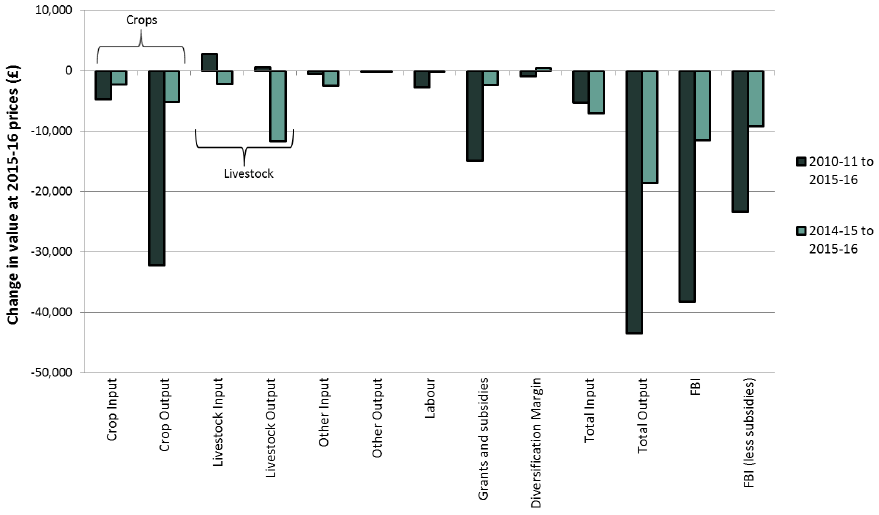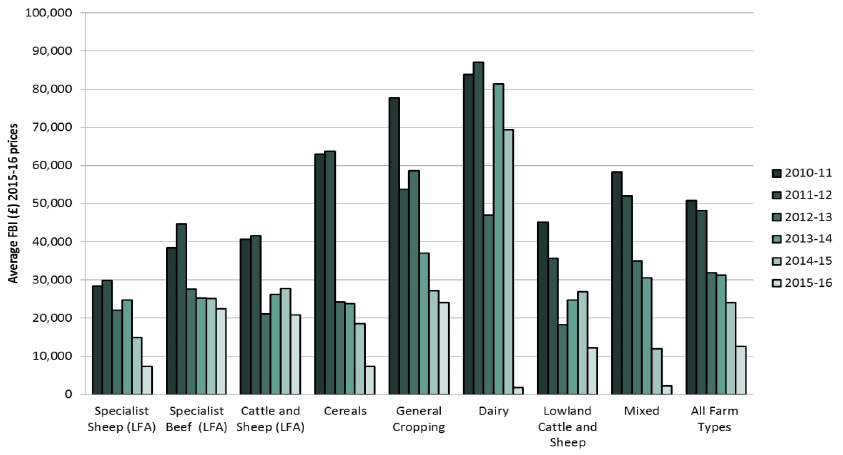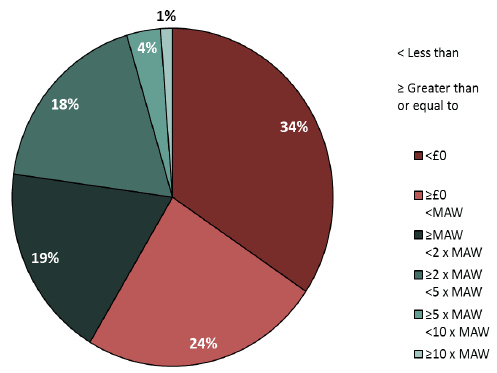Scottish farm business income: annual estimates 2015-2016
Farm business level estimates of average incomes for the accounting year 2015 to 2016, which relates to the 2015 crop year. For the most recent data, visit the Scottish farm business income (FBI) collection page below.
This document is part of a collection
2. Profitability
2.1 Farm Business Income ( Tables 1, 12)
Farm Business Income ( FBI) is the average headline business-level measure of farm income in the UK. FBI represents the return to the whole farm business, that is, the total income available to all unpaid labour and their capital invested in the business. Returns from diversified activities (non-agricultural activities that use farm resources, for example: renting out farm cottages for tourism; income from small/ medium scale wind turbines; etc.) are included in overall FBI.
Figure 1: Average FBI of Scottish farms

In 2015-16, the average FBI was £12,600, the lowest level in the last six years [ 2]. This is 48 per cent lower in real terms than the previous year, down £11,500 and 75 per cent lower in real terms since 2010-11.
When subsidy payments are excluded, the average FBI is a loss of £25,500 in 2015-16 [ 3]. For each of the last six years, FBI without subsidy payments has been a loss (Figure 1).
Changes in the components which make up FBI are shown in Figure 2 for the last year and over the six year series. Between 2014-15 and 2015-16 all spending on inputs and revenue from outputs decreased, except for revenue from diversified activities which increased by 19% to £2,800. Livestock and crop revenue reduced by a bigger margin that that for spending on inputs for these products within the last year. This, along with the reduction in the value of grants and subsidies, resulted in the overall fall in income.
The Basic Payment Scheme ( BPS) replaced the Single Farm Payment Scheme ( SFP) in 2015 as the method of allocating funding through Direct Payments. The 2015-16 Farm Business Survey ( FBS) was the first year to collect data on BPS and the average value of BPS subsidy and other support payments was £30,000 per farm in this year, a decrease of five per cent from 2014-15.
Revenues for livestock have improved over the six year series however this has been outweighed by a rise in spending on livestock inputs combined with a declining average value of subsidy payments. Crop outputs have almost halved in the last six years while crop inputs decreased by 15 per cent. Labour costs have fallen by around £2,800 when compared over the six years.
Figure 2: Changes to FBI components: all farm types

All eight farm types experienced a decrease in overall FBI between 2014-15 and 2015-16 (Figure 3). Dairy farms had the largest decrease with average FBI down 97 per cent (£67,600). This was largely due to the drop in milk prices over the last year from an average of £0.30 per litre in 2014-15 to £0.21 per litre in 2015-16. Mixed farms had the second largest percentage decrease in average FBI, down 81 per cent (£9,700). Lowland cattle and sheep farms profitability was down 54 per cent (£14,600), whereas LFA cattle and sheep farms were down 25 per cent (£6,900). The overall FBI for LFA sheep farms decreased by 51 per cent (£7,600) and for cereal farms it decreased by 60 per cent (£11,200). LFA cattle and general cropping farms had the smallest decrease in average FBI, both falling by 11 per cent, £2,700 and £3,100 respectively.
Figure 3: Average FBI by farm type

Analysis of individual farm types is presented in section 7.
2.2 Return to unpaid labour ( Table 1)
FBI does not include costs for unpaid labour (farmer, spouse, other partners, directors and managers) that are, to some extent, dependent on the income of the farm business. The unpaid FTE (full-time equivalent) of a farm is the number of hours worked by regular unpaid labour. One FTE is equal to 1,900 hours a year. Figure 1 shows the average FBI of Scottish farms per unit of unpaid labour.
Trends in FBI/ FTE over the six year series roughly mirror overall FBI at a reduced level; typically around a third lower. Over the last year, the average FTE for all farm types has remained relatively unchanged. In 2015-16 the overall average FBI/ FTE was £8,600, 48 per cent lower than the previous year. The biggest difference between FBI and FBI/ FTE was in 2010-11.
FBI/ FTE reveals more than FBI alone. When looking in more detail, for example by farm type (covered in later sections of this report), it can be seen that the average FTE varies. Therefore the finance available to remunerate unpaid labour, those with an entrepreneurial interest in the farm business, will also vary.
We can put the FBI/ FTE into context by comparing it to the minimum agricultural wage ( MAW) which farm owners are required to pay farm workers. This minimum wage is set in legislation each October. As the FBS does not fit within a single year of the legislation we have estimated a weighted MAW for comparison at £7.17 in 2015-16.
Figure 4: Average FBI/ FTE, relative to MAW 2015-16

Figure 4 shows that over half of farms in the 2015-16 Farm Business Survey generated income roughly equivalent to less than the MAW, per hour of unpaid labour. Five per cent of farms in the survey generated income at least five times the MAW, which is at least £35.85 per hour of unpaid labour.
Although the MAW may be less than what the person involved in this unpaid labour would expect to be paid, due to level of experience or qualifications, it is the legal minimum. It should also be noted that the income described by FBI should cover more than just the labour provided by the farm owner: there is also the unpaid management, provision for return on capital and provision of funds for further investment (beyond the depreciation charges included in costs). Comparison against the MAW is nonetheless a helpful indicator of the performance of farm businesses.
2.3 Relative performance ( Table 2)
There are many factors which contribute to the relative performance of a farm business. These include: tenure of the farm (with tenant farms having relatively higher overheads); prices and duration of contract for produce; supply costs and efficiency of application of inputs; level of indebtedness; as well as the motivations for farming and preferences for methods of farming of individual farm owners/managers. There are also factors which farm owners and managers have no control over, such as weather conditions, demand and the market context (for example prices of inputs). Due to these factors the profitability of farm businesses can vary greatly.
Figure 5 shows the average FBI of all farm types by quartile, i.e. the average for all farm businesses with the lowest 25 per cent of FBI values, the overall average, and the average of all farm businesses with the highest 25 per cent of FBI values. The quartile data provides an indication of how performance varies for each farm type but does not account for differences in the size and structure of the farms.
Figure 5: Average FBI by farm type and quartile (lowest 25 per cent, average and upper 25 per cent) for 2015-16

For all farm types in 2015-16 there was a considerable difference between higher and lower performing businesses. The overall average FBI of farms in the lower quartile was a loss of £30,700, while those in the upper quartile generated an average income of £66,600, more than five times the average FBI.
Dairy farms had the largest range in average FBI between lower and upper quartile businesses, with lower quartile farms averaging a loss of £85,600 and upper quartile farms having an average income of £112,000. These values are, respectively, the lowest and highest average FBI across all the farm types.
All lower quartile farms made an overall loss in terms of FBI in 2015-16. The average FBI of lower quartile farms ranged from a loss of £14,700 for LFA cattle and sheep farms to a loss of £85,600 for dairy farms. The average FBI for upper quartile farms ranged from £38,500 for lowland cattle and sheep to £112,000 for dairy farms.
As previously mentioned, the variation seen between the quartiles does not take into account the overall size of farms. Larger farm business will have larger input costs as well as revenue compared to smaller equivalent business but both could be working with equal efficiency.
Productivity of the various farm types per quartile is discussed further in Section 4.
Contact
Email: agric.stats@gov.scot
Phone: 0300 244 4000 – Central Enquiry Unit
The Scottish Government
St Andrew's House
Regent Road
Edinburgh
EH1 3DG
There is a problem
Thanks for your feedback